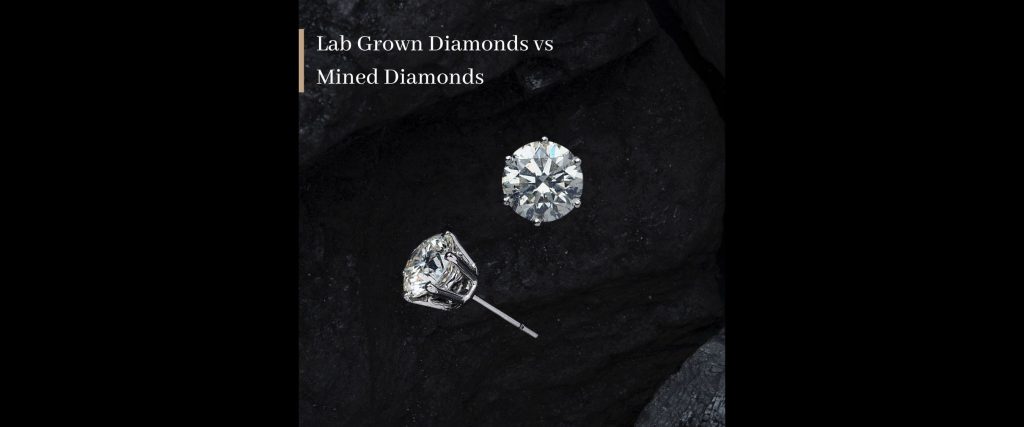
Although there is some confusion on whether natural diamonds are the same as lab grown diamonds, The difference isn't in the way they look. Since both lab-grown and natural diamonds are made of crystallised carbon, their appearances, physical, chemical, and optical properties are identical.
Continue reading as we contrast lab-grown diamonds with naturally occurring ones to dispel the myth that they are less valuable.
Lab-grown diamonds are man-made stones that are identical to their natural counterparts in every way except that they have been created by scientists in a highly controlled lab environment. Rather than being excavated from the ground, they are created from a diamond seed. The chemical composition, carbon atom structure, optical characteristics, and physical characteristics of lab-grown diamonds are identical to those of natural diamonds. The cost of a lab-grown diamond is 75% less than that of a mined diamond.
Two methods are commonly used to make lab-grown diamonds: HPHT (high pressure, high temperature) or CVD (chemical vapour deposition).
HPHT uses extreme temperature and pressure to mimic the way diamonds form naturally deep below the earth's crust. Using this method, researchers place a tiny diamond crystal inside a containment chamber and expose it to pure carbon. They then expose it to incredibly high temperatures and pressures, which cause the carbon to melt and form a lab-grown diamond around the diamond seed.
The CVD method begins by placing the diamond seed in a chamber. After heating this chamber to a very high temperature and filling it with gas rich in carbon, they use microwaves or lasers to ionise the gas. As a result, pure carbon separates from the carbon-rich gas, which then gradually forms a lab-grown diamond around the diamond seed.
Lab-grown diamonds can take a month or so to make, compared to a naturally sourced diamond that took billions of years to form deep under the earth’s surface.
A mined diamond is a diamond that was naturally made on the earth over 1 to 3 billion years. Natural diamonds form deep under the earth’s crust due to intense heat and pressure. Mined diamonds start their lives as carbon dioxide, and over time, with extensive pressure and heat, they will naturally modify into a solid stones. Natural diamonds were brought to the earth's surface by volcanic eruptions. Kimberlite pipes, a type of volcanic rock that is ready to be mined, contain natural diamonds. The earth contains only 5% of kimberlite pipes that are economically sensible to mine from the earth.
The path to obtaining a natural diamond to reach your fingure is a long and difficult one. They travelled to the earth’s surface in volcanic pipes, ascending a hundred miles in a column of molten rock, more than three times the depth of the average volcano. Due to their arduous journey, the vast majority of discovered diamonds are not of gem quality. Due to their scarcity, real diamonds have a high intrinsic value that will only rise as fewer and fewer of them are found in nature.
The price is the main distinction between lab-grown and natural diamonds. Typically a lab grown diamond price will cost between 60% and 80% less than a natural diamond with identical carat weight and grades. The difference is due to supply. Natural diamond supply is limited because it takes nature billions of years to create a diamond. However, because there is no supply limit on synthetic diamonds, the price decreases over time as supply increases.
A side-by-side comparison makes it impossible to distinguish between lab-grown and mined diamonds. To tell one from the other, you need specialised equipment. That is the case because they are completely similar.
Check the grading report on your diamond to make sure it was grown in a lab. It will also state the diamond's grade on all 4Cs of diamond, including carat weight, colour, clarity, and cut, in addition to the fact that it was grown in a lab. A grading report ensures that your diamond is of the quality you expect.
While some may think that lab grown diamonds can’t sparkle as brightly as mined diamonds, that’s just not true.
Natural diamonds and lab-grown diamonds both scored 10/10 on Moh's scale, indicating that they are both tough. Natural and lab-grown diamonds have the same hardness of 100%. Consequently, lab-grown diamonds are a viable alternative to natural diamonds.
Lab-created diamonds are indeed strong enough to be used in an engagement ring. On the Mohs scale of mineral hardness, lab-grown diamonds also rate a perfect 10 out of 10. This indicates that they are more durable than all other gemstones, including sapphires, rubies, moissanite, morganite, and emeralds (apart from mined diamonds, which are equally hard). For everyday rings like engagement rings, the majority of jewellers advise choosing ones with a Mohs scale rating of 9 or higher. Diamonds created in laboratories easily surpass this standard with a score of 10.
The brilliance, sparkle, and shine of lab-created diamonds are identical to those of a naturally mined diamond because they are real diamonds. If you want to increase the size or quality of the diamond you can buy while still staying within your budget. Then a lab/created diamond might be the best option for you.
A mined diamond is a better option for those who want to propose a diamond that has been naturally formed over billions of years on the earth.
At the end of the day, it will depend on each person’s values and preferences on choosing a mined or lab/created diamond.
V.Jayantilal & co., a top diamond manufacturing company in surat provide best quality diamond of all size and clarity at an affordable price.
If you require additional chic and lovely collections from "V. Jayantilal & Co.," then you must visit our website. We want to reassure you that you are welcomed as a friend rather than a customer.